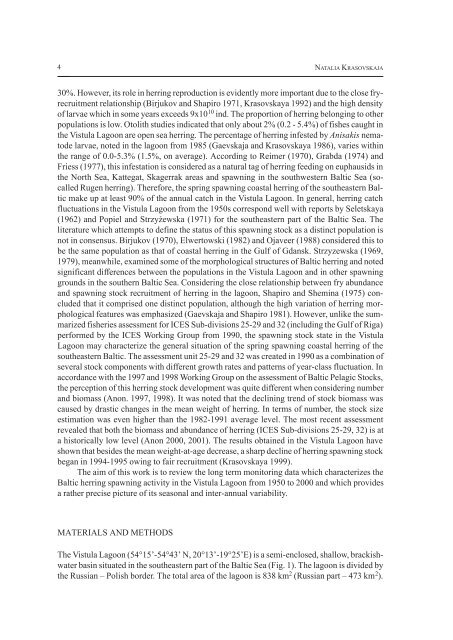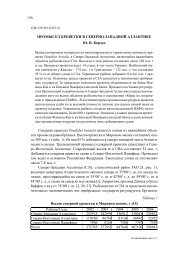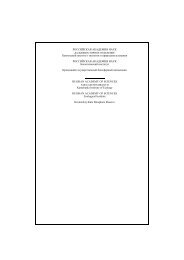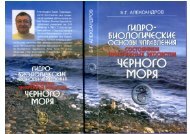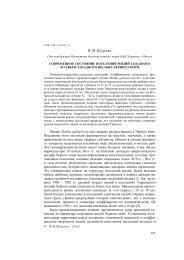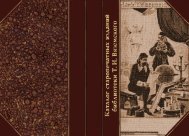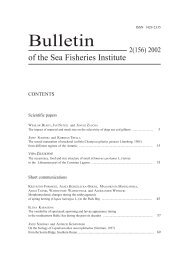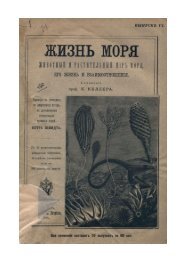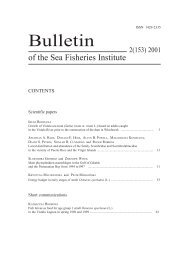Bulletin of the Sea Fisheries Institute 1 (155) 2002 - CEEMaR
Bulletin of the Sea Fisheries Institute 1 (155) 2002 - CEEMaR
Bulletin of the Sea Fisheries Institute 1 (155) 2002 - CEEMaR
You also want an ePaper? Increase the reach of your titles
YUMPU automatically turns print PDFs into web optimized ePapers that Google loves.
4<br />
NATALIA KRASOVSKAJA<br />
30%. However, its role in herring reproduction is evidently more important due to <strong>the</strong> close fryrecruitment<br />
relationship (Birjukov and Shapiro 1971, Krasovskaya 1992) and <strong>the</strong> high density<br />
<strong>of</strong> larvae which in some years exceeds 9x10 10 ind. The proportion <strong>of</strong> herring belonging to o<strong>the</strong>r<br />
populations is low. Otolith studies indicated that only about 2% (0.2 - 5.4%) <strong>of</strong> fishes caught in<br />
<strong>the</strong> Vistula Lagoon are open sea herring. The percentage <strong>of</strong> herring infested by Anisakis nematode<br />
larvae, noted in <strong>the</strong> lagoon from 1985 (Gaevskaja and Krasovskaya 1986), varies within<br />
<strong>the</strong> range <strong>of</strong> 0.0-5.3% (1.5%, on average). According to Reimer (1970), Grabda (1974) and<br />
Friess (1977), this infestation is considered as a natural tag <strong>of</strong> herring feeding on euphausids in<br />
<strong>the</strong> North <strong>Sea</strong>, Kattegat, Skagerrak areas and spawning in <strong>the</strong> southwestern Baltic <strong>Sea</strong> (socalled<br />
Rugen herring). Therefore, <strong>the</strong> spring spawning coastal herring <strong>of</strong> <strong>the</strong> sou<strong>the</strong>astern Baltic<br />
make up at least 90% <strong>of</strong> <strong>the</strong> annual catch in <strong>the</strong> Vistula Lagoon. In general, herring catch<br />
fluctuations in <strong>the</strong> Vistula Lagoon from <strong>the</strong> 1950s correspond well with reports by Seletskaya<br />
(1962) and Popiel and Strzy¿ewska (1971) for <strong>the</strong> sou<strong>the</strong>astern part <strong>of</strong> <strong>the</strong> Baltic <strong>Sea</strong>. The<br />
literature which attempts to define <strong>the</strong> status <strong>of</strong> this spawning stock as a distinct population is<br />
not in consensus. Birjukov (1970), Elwertowski (1982) and Ojaveer (1988) considered this to<br />
be <strong>the</strong> same population as that <strong>of</strong> coastal herring in <strong>the</strong> Gulf <strong>of</strong> Gdansk. Strzyzewska (1969,<br />
1979), meanwhile, examined some <strong>of</strong> <strong>the</strong> morphological structures <strong>of</strong> Baltic herring and noted<br />
significant differences between <strong>the</strong> populations in <strong>the</strong> Vistula Lagoon and in o<strong>the</strong>r spawning<br />
grounds in <strong>the</strong> sou<strong>the</strong>rn Baltic <strong>Sea</strong>. Considering <strong>the</strong> close relationship between fry abundance<br />
and spawning stock recruitment <strong>of</strong> herring in <strong>the</strong> lagoon, Shapiro and Shemina (1975) concluded<br />
that it comprised one distinct population, although <strong>the</strong> high variation <strong>of</strong> herring morphological<br />
features was emphasized (Gaevskaja and Shapiro 1981). However, unlike <strong>the</strong> summarized<br />
fisheries assessment for ICES Sub-divisions 25-29 and 32 (including <strong>the</strong> Gulf <strong>of</strong> Riga)<br />
performed by <strong>the</strong> ICES Working Group from 1990, <strong>the</strong> spawning stock state in <strong>the</strong> Vistula<br />
Lagoon may characterize <strong>the</strong> general situation <strong>of</strong> <strong>the</strong> spring spawning coastal herring <strong>of</strong> <strong>the</strong><br />
sou<strong>the</strong>astern Baltic. The assessment unit 25-29 and 32 was created in 1990 as a combination <strong>of</strong><br />
several stock components with different growth rates and patterns <strong>of</strong> year-class fluctuation. In<br />
accordance with <strong>the</strong> 1997 and 1998 Working Group on <strong>the</strong> assessment <strong>of</strong> Baltic Pelagic Stocks,<br />
<strong>the</strong> perception <strong>of</strong> this herring stock development was quite different when considering number<br />
and biomass (Anon. 1997, 1998). It was noted that <strong>the</strong> declining trend <strong>of</strong> stock biomass was<br />
caused by drastic changes in <strong>the</strong> mean weight <strong>of</strong> herring. In terms <strong>of</strong> number, <strong>the</strong> stock size<br />
estimation was even higher than <strong>the</strong> 1982-1991 average level. The most recent assessment<br />
revealed that both <strong>the</strong> biomass and abundance <strong>of</strong> herring (ICES Sub-divisions 25-29, 32) is at<br />
a historically low level (Anon 2000, 2001). The results obtained in <strong>the</strong> Vistula Lagoon have<br />
shown that besides <strong>the</strong> mean weight-at-age decrease, a sharp decline <strong>of</strong> herring spawning stock<br />
began in 1994-1995 owing to fair recruitment (Krasovskaya 1999).<br />
The aim <strong>of</strong> this work is to review <strong>the</strong> long term monitoring data which characterizes <strong>the</strong><br />
Baltic herring spawning activity in <strong>the</strong> Vistula Lagoon from 1950 to 2000 and which provides<br />
a ra<strong>the</strong>r precise picture <strong>of</strong> its seasonal and inter-annual variability.<br />
MATERIALS AND METHODS<br />
The Vistula Lagoon (54°15’-54°43’ N, 20°13’-19°25’E) is a semi-enclosed, shallow, brackishwater<br />
basin situated in <strong>the</strong> sou<strong>the</strong>astern part <strong>of</strong> <strong>the</strong> Baltic <strong>Sea</strong> (Fig. 1). The lagoon is divided by<br />
<strong>the</strong> Russian – Polish border. The total area <strong>of</strong> <strong>the</strong> lagoon is 838 km 2 (Russian part – 473 km 2 ).


